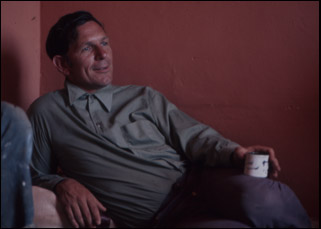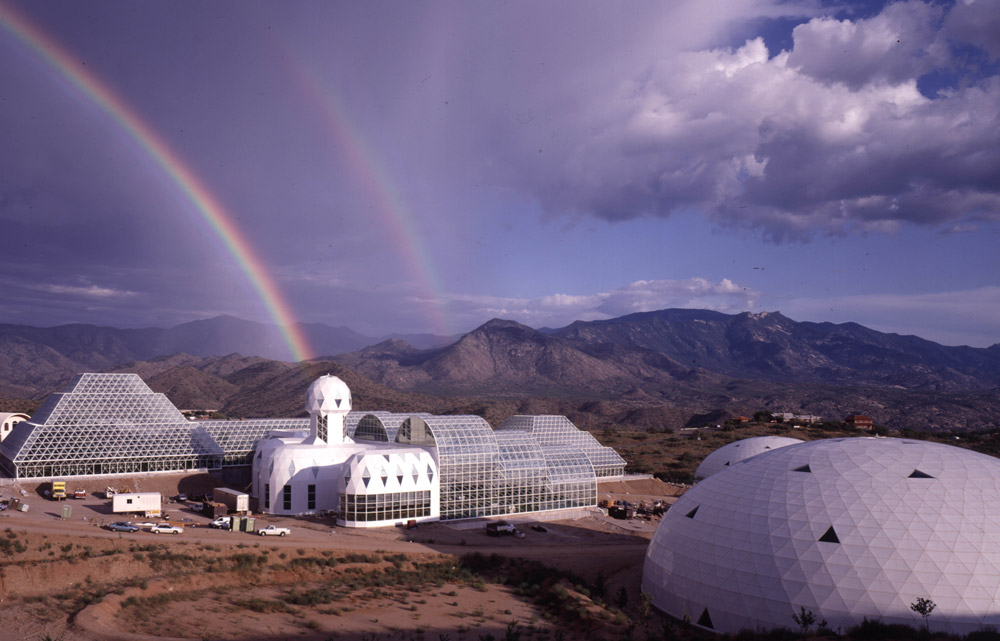When Matt Wolf got to the Synergia Ranch in New Mexico, he didn’t know what he would find. For the filmmaker behind such archival-heavy films as “Recorder: The Marion Stokes Project” and “Teenage,” this is often the most exciting part of the process and he was more than willing to make the trek from New York to the desert based on just a little due diligence and a single photo that he came across online of eight people he saw standing in front of a glass pyramid in bright red jumpsuits, thinking perhaps it was a still from a sci-fi movie he hadn’t seen. He would later learn the Biosphere 2 endeavor was inspired by one – “Silent Running” – but in fact, no movie had been made yet about the ambitious project in Oracle, Arizona where a group that emerged from the Theater of All Possibilities, a countercultural movement that brought together the arts and sciences, had set up a two-year experiment in 1991 in which they would attempt to live in an ecological environment of their own creation, perhaps laying the foundation for what human life could look like on another planet.
Wolf couldn’t help but be shocked when he was led back to a room at the Ranch with hundreds of hours of footage from the experiment, as well as visual documentation of the many other projects the Synergists had embarked on over the years from their earliest days staging plays in San Francisco to launching the Heraclitus Research Vessel, a battleship that they fashioned to sail the world collecting scientific data. Looking at the celluloid that few, if anyone else, had seen before, it was like Wolf could’ve been the one behind the camera himself when there was such dedication to chronicling every aspect of the Biosphere experience and the Synergists had complete control over what went on inside the concealed space — and better yet, as a storyteller, there was a natural conflict given that they had no control over what happened outside of it.
“Spaceship Earth,” the invigorating end result of Wolf’s discovery, is a film that may have greater relevance in the time of a global pandemic for reasons both large (societal reorientation) and small (interpersonal dynamics in close confinement), but was always going to make a revisit to the Biosphere 2 experiment worthwhile in how a skeptical public perception of the project, shaped by media coverage, ultimately doomed it to failure. With $200 million in funding for its plans to be a regenerative experiment, refining what didn’t work in the ecosystem after every two years, the Biosphere 2 project ended after just one cycle, becoming a punchline for late night talk show hosts and topical fodder for morning shows where the Synergists were seen as oddities to be observed much like animals at a zoo, with their pairing of theatricality and science making it impossible for them to be taken seriously when it was the intersection of those disciplines that opened up so many ideas and opportunities for them.
Honoring their efforts in every way possible, “Spaceship Earth” is the biggest-scale project that Wolf has undertaken as well, given the grandeur it deserves with an epic orchestral score from Owen Pallett and a historical sweep from David Teague’s canny editing that covers five decades of the Theater of All Possibilities with considerable weight while feeling no time has passed at all for this group of innovators. With the film making its way to virtual cinemas — and some real world drive-ins – this week, Wolf shared how the film came together, both in its origins for him and pulling such a disperse history into the proper context, as well as the questions he asks himself on every project to get the most interesting answers.

I’m obsessed with archival footage and tapping into these collections that have singular material that can’t be found anywhere else, so when I entered that room, I was just floored. I couldn’t believe it, not just because it was an opportunity for me to make an interesting film, but because it changed my perception of this group who called themselves the Synergists in that they recognized what they did was historically significant and they made a commitment to document it. But what was so poignant is that so much of their work had been discounted and a lot of their life’s work had actually been taken away from them, so to have this archive and to know what they did was of historical significance felt both like a huge opportunity for me, but also a big responsibility to make use of it in a meaningful way.
Was it easy for you to connect the dots between all their various projects before Biosphere 2?
No, the backstory’s confusing and I think that’s the reason that a lot of people haven’t previously appreciated this group. It’s also probably the reason why they didn’t necessarily share their backstory because what they did was very expansive. They built a ship, then they started art galleries and did ecological projects and all of these business enterprises. It’s complicated. But I think connecting the dots between those things was a big part of my job and this is true of Marion Stokes [from “Recorder”] as well – sometimes the people with the most complicated ideas, they don’t make a lot of sense until you step back and look at the full picture.
Looking at the full picture [for “Spaceship Earth”], I became convinced that there really was a continuous line of thought and inquiry that started at the earliest days of the Synergia Ranch and found its synthesis and biggest expression in Biosphere 2 — All of those ideas are super interesting and relevant today, but because of the complexity of the network of projects and the different inspirations and ways of thinking that this group was drawing on, a lot of that got lost into a more superficial or sensational view of their group. At the same time, what I also liked about the group is that they have a sense of humor. There’s a wackiness and a theatricality towards everything that they do and the fact that these were artists pursuing [scientific] projects was particularly interesting to me. It came as no surprise to me that it would be a group of artists who would imagine something unprecedented like this. That’s what artists do. But of course, their unconventional backgrounds proved to be a huge source of controversy on the project.

Not necessarily. I’m always trying to create a composite of different perspectives to create a bigger picture and whether or not people are bringing to life a subject or someone that is no longer around or if they’re all part of a network of ongoing relationships, a goal is to recount a history through a personal point of view. Everyone who was involved in this project has a different point of view about it and they’re all interesting, complicated people, so the way I make all my films is I prepare all my interviews in advance of doing anything. It’s actually the most labor intensive part of my process. I do all my research and I consider the different, potentially conflicting perspectives people might have over a story or certain issues and I plot out how I’m going to get people to discuss all of those things in such a fashion that can tell a story, but also add a personal interpretation to that story and its details. But it’s always the same process of plotting out this tapestry of people and their points of view.
I can’t remember whether it was you or your editor David Teague who I heard say this at Sundance, but it was said you took inspiration from the Theater of All Possibilities founder John Allen’s quote, “Increase the challenge every time.” Did you feel you got to push yourself to new places with this?
Yeah, it’s actually really interesting. I had a tight-knit group of collaborators myself on this project and I feel David and I, in the edit room, were really able to push each other to the next level in terms of our creativity, so it’s nice that you bring him up. I’ve never dealt with a story that has so many twists and turns with such a large cast of characters. It’s really an epic. It’s a story that unfolds over half a century, so it was challenging, but in some ways no different than the other stories I’ve taken on. With “Recorder,” I was grappling with the totality of media for three decades. [laughs] I like to push the limits of my own abilities and take on archives and ideas that feel super huge, but are channeled through really specific stories and at the end of the day, it’s all about relationships – relationships with my subjects, but also relationships with my collaborators and I think it’s us as people who challenge each other and push each other to new creative and artistic realms.

Honestly, the hardest part of making a film is what’s the bigger point? A friend of mine once said, “When you make a film, you have to ask, so what and why now?” The “why now” intuitively felt pretty clear as we’re struggling with climate change and models of dealing with it that aren’t working. But the “so what” was really this experiment that’s perceived as a failure and in some ways, it was triumphant, so I thought, “What’s the point?”
As I was mining the material, I realized this whole point of small groups as this unique model for pursuing unprecedented projects really struck me as something that’s relevant today. We live in a world in which it’s really, really difficult to create consensus among huge groups of people. It’s what makes social movements feel more and more fractured. But this idea that we can coalesce around a much smaller group and impact a certain kind of change in our little miniature worlds – in our little Biosphere 2s — is really compelling because if everybody is forming small groups and uniting around common goals, a lot of things can happen in a different way. I realized this is ultimately a film about small groups and within that model, people were able to literally reimagine a world and that has really taken on a new significance in this whole pandemic that we’re in right now.
Since you were able to premiere at Sundance with some of the Biospherians in attendance, what was it like seeing these people to be appreciated for what they did after being considered a failure for so long?
It’s really gratifying. It’s gratifying to have intentions to take people seriously who have been discounted. That doesn’t mean I’m going to valorize them or idealize them. It means that I’m making the film because I take them seriously and I take what they did seriously and I’m going to invest everything I’ve got into telling their story. And the subjects of the film had not seen the film until the premiere at Sundance, so that was an incredibly nerve-wracking premiere for me. But when we were up at the Q & A and the audience gave them a standing ovation, I could see in the side of my eye, [the Theater of All Possibilities co-founder] Marie Harding crying, it really just struck me that I had taken on a big responsibility to tell these people’s stories. I was so relieved that they felt recognized and that felt I had found the truth in terms of what had happened to them and that’s all I can really hope for when I ask people for their trust to make a film.
“Spaceship Earth” will be available on May 8th through virtual cinemas that will benefit your local arthouse theater or arts organization, iTunes, FandangoNow, Google Play, and Vudu.




